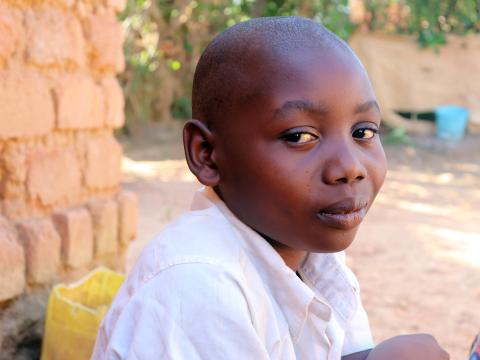DR Congo: From work in the mines to school: The story of Steve

By Tatiana Ballay - Communications officer World Vision DRC
Steve is the eldest child in his family. He lives with his mother, younger brother and 3 younger sisters. They live in the Kisunka district, in the east of the town of Likasi, in the province of Haut-Katanga in the Democratic Republic of Congo.
At 13, the sole provider for his family
Although he is only 14 at the moment, Steve already has a great deal of experience. When his father abandoned them in 2022, Steve, 13 years old, had to leave secondary school and start work in a quarry crushing building materials. A year ago, he was the only person to have a source of income and support this family of six.
"I used to get up at 6 o'clock and go to the quarry. I had to find a good spot and spend the whole day breaking stones with my club, in the dust. At the end of the day, I could fill five bags, which were sold individually for 2,000 Congolese francs (USD 0.82). Sometimes I could sell five bags in a day and earn 10,000 Congolese francs (USD 4.09)," explains 14-year-old Steve.
Dropping out of school and taking on a back-breaking job was one of the bad experiences Steve had at an early age. Exposed to adverse weather conditions and other dangers, he remembers all that he faced alongside the other children working in the mines.
"When I got home, my whole body ached and I had to go back the next day. It was very sad, the bags were so heavy. The money was barely enough to feed ourselves. Children were getting sick all the time," he adds.
Raised by a mother with a strong heart
As the mother of 5 children, Mireille had to do her best to cope with a life that had been turned upside down by her husband's departure.
"My husband left us three years ago to start a new life in Pweto," says Steve's mother, Mireille.
To provide for her family after her husband abandoned them, Mireille was forced to delegate some of her responsibilities to her child because of the myths.
Work in the mines is the most accessible for most members of the community. Women like Mireille are forbidden access to mining sites because of traditional beliefs, and are prevented from working there on the grounds that it would make their careers unproductive. Steve's mother was forced to let her son work despite his age because of this myth, which is so widespread in the region.
"According to our customs, women are not allowed to go to the quarry and work. Our culture considers women to be impure and their presence in a quarry can cause misfortune. Ba nioka Ba Majiba (the snake with breasts), that's what we're called. That's why my son worked there instead of me. I waited outside for him to come back with the bags of rubble and gravel, and I helped him sell them", explains Mireille.
World Vision supports child protection
World Vision DRC is supporting the Congolese government in protecting children rights in Haut-Katanga Province through a system of community awareness-raising and a range of specific interventions. These activities aim to strengthen child protection mechanisms at community level, to combat abuse, neglect, exploitation and other forms of violence against children.
In 2023, 507 children who had dropped out of school, most of them working in quarries, were made aware of their rights and the need to return to school.
Only 30 have returned to school and two children have been taken out of the quarries, including Steve. Steve has been back at school for nearly 8 months and is gradually adapting with the help of RECOPE (Community network for child protection). Steve dreams of finishing his studies, finding a job and taking care of his family.
In Kisunka, the Community network for child protection supported by World Vision is encouraging the children to stay in school and complete their education.
Child labour in artisanal mines and quarries remains a major challenge in the Democratic Republic of Congo.
World Vision has been committed to supporting the Congolese government to eradicate this scourge since 2016, through its campaign against the worst forms of child labour. However, resources are limited given the scale of the problem. There is a huge need for more resources to put an end to child labour.
To date, no recent quantitative study has provided details of the number of children involved. In 2014, estimates showed that the number of children working in artisanal mines and quarries was around 40,000, a large proportion of whom were in the copper and cobalt belt in Haut-Katanga and Lualaba. Around 143,000 children aged 5-17, or 24%, are involved in domestic or economic work that exceeds the recommended hourly thresholds.